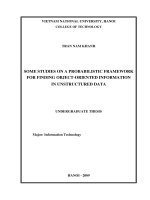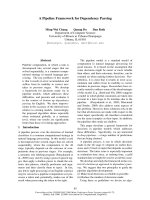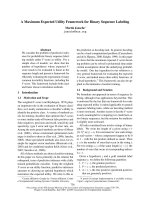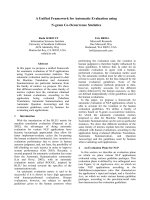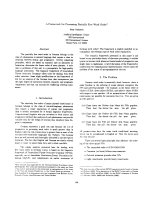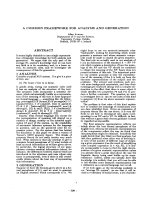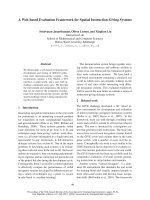multiple dataset visualization (mdv) framework for scalar volume data
Bạn đang xem bản rút gọn của tài liệu. Xem và tải ngay bản đầy đủ của tài liệu tại đây (3.74 MB, 163 trang )
A Dissertation
Submitted to the Graduate Faculty of the
Louisiana State University and
Agricultural and Mechanical College
in partial fulfillment of the
requirements for the degree of
Doctor of Philosophy
In
The Department of Computer Science
By
Gaurav Khanduja
B.E., Madan Mohan Malaviya Engg College, 2002
M.S., Louisiana State University, 2005
May 2009
MULTIPLE DATASET VISUALIZATION (MDV)
FRAMEWORK FOR SCALAR VOLUME DATA
ii
To My Parents, Family
And
My beloved wife, Swati
iii
ACKNOWLEDGMENTS
Foremost of all, I would like to thank my major advisor Dr. Bijaya B. Karki for guiding me
through various stages of uncertainties and doubts. When I did not know what I was doing,
he was the one who supported me, believed in me and guided me. I would also like to thank
Dr. S. Sitharama Iyengar, Dr. Jianhua Chen and Dr. Brygg Ullmer for agreeing to be in my
dissertation committee and providing valuable feedback. I would like to thank Dr. Charles
Delzell, the dean’s representative, for his interest and constantly asking questions about
the status of the work. I would like to acknowledge Dr. Ashok Verma and Dipesh Bhattarai
for providing a stimulating intellectual environment in our laboratory and acting as a
sounding board when I was not sure about the worth of my own thoughts. I would also like
to express my thanks to Ms. Vera Watkins and Ms. Amy Fowler for taking care of the
administrative details so that I could focus on my work. I would also like to express my
gratitude to the whole Department of Computer Science for providing such an excellent
environment for intellectual pursuit.
I would also like to acknowledge the support from National Science Foundation and NASA
for this research.
I would not be here with this work if it were not for my family. Their excitement was
always source of my energy that kept on motivating me through these four and half years.
Last but not the least; I would like to express my sincere gratitude to my parents and my
beloved wife, Swati, for pushing me hard so that I could finish this dissertation. They would
not settle for less than the finished work. If it was not for them, I would not have been able
to finish. This work belongs to them as much as it does to me.
iv
TABLE OF CONTENTS
ACKNOWLEDGMENTS iii
LIST OF TABLES …………………………………………………….…………………………………………………….vii
LIST OF FIGURES viii
ABSTRACT……………………………………………………………… ………………………………………………….xiv
1. INTRODUCTION 1
1.1 What Is Visualization? 1
1.2 Multiple Dataset Visualization 2
1.3 MDV Techniques 3
1.4 Challenges In MDV 5
1.4.1 Memory Requirement 5
1.4.2 Visualization Display 7
1.4.3 Performance and Interactivity 7
1.5 Areas of Application 8
1.6 Thesis Organization 10
2. RELATED WORK 11
2.1 Multiple Datasets 11
2.2 Computer Graphics 12
2.2.1 Coordinate System in 3D Computer Graphics 12
2.2.2 3D Graphics Rendering Pipeline 14
2.3 Overview of Visualization Techniques 15
2.3.1 Ray Casting 16
2.3.2 Splatting 17
2.3.3 Shear-Warp 17
2.3.4 2D and 3D Textures 18
2.3.5 Isosurface Extraction 18
2.4 Isosurface Rendering Technique 18
2.4.1 Introduction 18
2.4.2 Marching Cubes Algorithm 19
2.4.3 Dividing Cubes Algorithm 22
2.4.4 Span Space Based Approach 24
2.4.5 Isosurface Extraction Using Ray Tracing 25
2.5 Texture Mapping Technique 26
2.5.1 2D And 3D Textures 27
v
2.5.2 3D Texture Based Volume Rendering 28
2.5.3 Clipping 30
3. MDV FRAMEWORK 34
3.1 What Is Framework? 34
3.2 MDV Framework 35
3.2.1 Architecture 35
3.2.2 Multithreaded View 37
3.3 Data Loading Module 39
3.4 Visualization Module 40
3.5 Rendering Module 42
3.5.1 Rendering Time 43
3.6 Results 45
3.7 Implementation 47
4. ISOSURFACE EXTRACTION FOR MDV 49
4.1 MDV Framework and Isosurface Technique 49
4.2 Data Structure 49
4.3 Rendering Primitives 52
4.4 Visualization Techniques 53
4.4.1 All-In-Memory (AIM) Method 54
4.4.2 Only-Polygons-in-Memory (OPIM) Method 55
4.4.3 Performance Analysis 57
4.4.4 Performance Analysis (Points vs. Polygons) 60
4.5 Improving Isosurface Extraction for MDV 63
4.5.1 Data Coherency 63
4.5.2 Multi-Resolution 73
4.5.3 Quasi-4D Isosurface Extraction 84
5. TEXTURE-BASED RENDERING FOR MDV 88
5.1 Introduction 88
5.2 Texture Mapping 91
5.3 Transfer Function 91
5.4 Volume Rendering 92
5.5 External 3D Surface Rendering 94
5.6 Clipping 96
5.6.1 Clipping with External Surface Rendering 96
5.6.2 Volume Clipping 99
5.7 Hardware Isosurface Extraction 101
5.8 Hardware Based Isosurface Difference 102
5.9 DR Based Texture Mapping 103
5.10 Volume Shading 105
5.11 Performance Analysis 108
vi
6. APPLICATIONS: VISUALIZATION OF ELECTRON DENSITY DATA 112
6.1 Simulation Data 113
6.2 Simulation Data Visualization 114
6.2.1 MgO Data 114
6.2.2 MgSiO
3
Data 119
7. CONCLUSIONS AND FUTURE DIRECTIONS 124
7.1 Conclusions 124
7.2 Future Directions 126
REFERENCES…………………………………………………………………………………………………………… 128
APPENDIX A. PSEUDO CODE 136
A. 1. MDV Framework 137
A. 2. AIM Method 137
A. 3. OPIM Method 138
A. 4. Rendering Module 139
A. 5. Data Coherency 140
A. 6. Quasi-4D Isosurface Extraction 141
A. 7. Multi-Resolution 142
A. 8. Clipping 143
A. 9. Hardware Isosurface Extraction 144
APPENDIX B. PARALLEL IMPLEMENTATION OF THE FRAMEWORK 145
VITA………………………………. 148
vii
LIST OF TABLES
Table 1: Number of triangles with overlapping 69
Table 2: Description of terms in lighting equation 106
viii
LIST OF FIGURES
Figure 1: Ways for multiple dataset visualization 4
Figure 2: Two cubic volumes with spherical isosurface 6
Figure 3: MDV of 25 sets of electronic charged density using 3D surface texture mapping
with planar clipping. The color and opacity values for each pixel are based on the density
value associated with that pixel. A multiscale RGB color mapping is used. B represents
values from 0 to 0.05, G is added to represent values up to 0.4 and then R is increased and
both B and G are decreased for higher values. 9
Figure 4: Graphics Rendering Pipeline 14
Figure 5: Marching Cube cell 20
Figure 6: Different cases for intersection of surface with cube [4] 22
Figure 7: Span space for NIOSE algorithm 24
Figure 8: Division of span space for ISSUE algorithm 25
Figure 9: Relationship of 2D and 3D Textures 27
Figure 10: Basic steps in the visualization process 34
Figure 11: Multiple Dataset Visualization 36
Figure 12: Multithreaded Architecture 37
Figure 13: MDV Framework 38
ix
Figure 14: Isosurface difference using GPU. Arrows show the difference in the isosurface in
the box. First difference is based on data and second difference is based on depth using
GPU. 41
Figure 15: Texture based difference for the magnesium silicate datasets. 43
Figure 16: Responsiveness and Latency for single and multi thread scenario 46
Figure 17: Single thread vs. Multi thread - Responsiveness (for marching cube and
rendering time) 46
Figure 18: MDV Framework for isosurface extraction 49
Figure 19:Quadtree for calculating isosurfaces [71] 50
Figure 20: Octree for isosurface construction [72] 51
Figure 21: AIM Scheme 54
Figure 22: OPIM Scheme 56
Figure 23: Isosurface for isovalue = 0.02, 0.04, and 0.08 (left to right)[16] 57
Figure 24: AIM polygon generation (T
G
) and rendering (T
R
) times for isovalue = 0.02, 0.04
and 0.08 [16] 58
Figure 25: OPIM polygon generation (T
G
) and rendering (T
R
) times for isovalue = 0.02, 0.04,
0.08 [16] 59
Figure 26: AIM scheme 61
Figure 27: OPIM scheme 62
Figure 28: Visualization of electronic charge density using the data coherency technique.
(a) Perfect crystal (reference data); (b) and (c) Non-reference data. Light region from
reference dataset; dark region is directly extracted. 65
x
Figure 29: Overlapping for eliminating crack in the dataset. (a) Reference isosurface; (b)
Non-reference isosurface; (c) Approximated isosurface with cracks; (d) Approximated
isosurface without crack 67
Figure 30: Effect of tolerance factor on polygon generation time with increasing number of
datasets 70
Figure 31: Effect of tolerance factor on polygon rendering time with increasing number of
datasets 71
Figure 32: Effect of block size on polygon generation time with increasing number of
datasets 72
Figure 33: Hybrid resolution approach 74
Figure 34: Mixed resolution approach 75
Figure 35: DR-MDV: Polygon generation (top) and rendering (bottom) times for isovalue =
0.04 for three criteria 78
Figure 36: DR-AIM - Point vs. Polygons 80
Figure 37: Multi-Resolution for 0.01 (Left) and 0.04 (Right) isovalue. Top row shows
isosurfaces at HR, second row shows isosurfaces at LR, third row shows surfaces at LLR
and last row shows isosurfaces mixed resolution (HR and LLR) 81
Figure 38: Isosurface generation time for multi resolution 82
Figure 39: Rendering time for multiresolution 83
Figure 40: Quasi-4D Isosurface 85
Figure 41: Quasi-4D Isosurface for magnesium silicate liquid (A) Slice 1 at isovalue of 0.5.
(B) Slice 15 at isovalue of 0.3 (C) Slice 15 at isovalue of 0.7 (D) – Slice 25 at the isovalue of
0.7 86
xi
Figure 42: Quasi-4D Isosurface for magnesium silicate liquid. Slice 1-17 for each dataset at
isovalue of 0.3 from different views. (D) Discontinuities in the dataset due to slices at
different level are adjacent to each other. 87
Figure 43 : Memory bandwidth in different parts of computer system [86] 88
Figure 44: Texture mapping process 89
Figure 45: Visualization of electron density difference induced by the Mg (left), Si (centre)
and O (right) vacancies in the 60-site MgSiO3 system. First and second rows show final
configuration (after atomic structural optimization) for migrating ion and fixed vacancy
respectively. Third and fourth rows show the corresponding initial configuration. 90
Figure 46: Transfer function for the scalar volume data. Red, green and blue curve
represents the transfer function T
R
, T
G
and T
B
respectively. R
MIN
and R
MAX
are the maximum
and minimum value in the dataset. 92
Figure 47: Volume Rendering 93
Figure 48: Surface rendering using texture mapping 95
Figure 49: Intersection of triangle and plane 97
Figure 50: Planar and box clipping 99
Figure 51: Volume clipping using textures 100
Figure 52: Isosurface extraction using textures 102
Figure 53: Isosurface difference using GPU for MgSiO
3
data. Arrows show the difference in
the isosurface in the box. First difference is based on data and second difference is based on
depth using GPU. 103
Figure 54: (a) Rendering time for various techniques without shading with DR. (b)
Rendering time for various techniques with shading with DR. (VR- volume rendering, SR –
surface rendering, VC- voxelized clipping, IE- isosurface extraction) 104
xii
Figure 55: Rendering time for various techniques without volume shading. The inset shows
the first transition in the low N regime. (VR- volume rendering, SR – surface rendering, VC-
voxelized clipping, IE- isosurface extraction) 110
Figure 56: Rendering time for various techniques with shading. The inset shows the first
transition in the low N regime. (VR- volume rendering, SR – surface rendering, VC-
voxelized clipping, IE- isosurface extraction) 111
Figure 57: MgO super cell (red circles indicate the positions of the oxygen atoms and blue
indicate the positions of the magnesium atoms 114
Figure 58: Visualization of atomic displacements induced by a) the Mg
2+
vacancy and b) the
O
2-
vacancy in the 216-site system. The size of the sphere and the orientation of the line,
respectively, represent the magnitude and direction of the displacement of a given atom
(Mg or O) relative to its position in the perfect crystal. Note that some minimum size is
given to each sphere to make it visible on display. The Mg and O atoms are displayed by red
and blue sphere, respectively, whereas the vacancy site is displayed by green sphere. In
Figure a) for the Mg
2+
vacancy, the nearest (N) neighboring atoms (the first shell) are the
largest blue spheres, the next-nearest (NN) neighboring atoms (the second shell) are the
largest red spheres, the next-next-nearest (NNN) neighboring atoms (the third shell) are
the second-largest blue spheres and so on. [96] 115
Figure 59: Top: Mg and O vacancy defect in MgO. Bottom: migrating defect in MgO for
migrating Mg and O ion 116
Figure 60: Texture based MDV off our sets of electronic charge density distributions of
liquid MgO. The color and opacity values for each pixel are based on the density value
associated with that pixel: a multiscale RGB color mapping is used. B represents values
from 0 to 0.05, G is added to represent values up to 0.4 and then R is increased and both B
and G are decreased for higher values 118
Figure 61: Isosurfaces for eight sets of the electronic charge density data for solid MgO at
different compressions (compression increasing from the lower left to the upper right).
The structures represent the charge distribution around o ion sites. 119
Figure 62: Visualization of atomic displacements. Upper row: Mg (left), Si (center), and O
(right) vacancies in the 60-site post-perovskite system at 120 GPa. Green, blue and red
spheres represent Mg, Si and O atoms, respectively. A black sphere at the center of the
supercell indicates the defect (vacant site) site. Lower row: Mg (left), Si (center) and O
(right) migrating ions located at the center of the supercell. Adjacent vacancy sites are
xiii
indicated by two black spheres located on each side of the center along the line of
migration. 120
Figure 63: Visualization of electron density difference (in units of Å
−3
) in MgSiO
3
post-
perovskite. Upper three images are for vacancies and lower three images are for migration:
Mg (left), Si (center) or O (right). In each case, the vertical surface represents the clipping
plane passing through the defect side or migrating ion site, which is located at the center of
the image. Note that the plane also contains the migration direction. 121
Figure 64 Visualization of electron density difference (in units of Å
−3
) induced by the Mg
2+
(left), Si
4+
(centre) and O
2−
(right) vacancies in the 160-site system at zero pressure (upper
three) and 150 GPa (lower three). A box clipping is used to show the interior of the volume
by removing the exterior portion of the volume data. In each image, three visible surfaces
represent the planes perpendicular to three axes intersecting at defect site, which is the
front upper right corner. 122
Figure 65: Isosurface Extraction of MgSiO3 showing Mg, Si and O vacancy from left to right
with isovalue 0.021. Top layer shows the isosurface after the optimization and lower layer
shows the isosurface before the optimization 123
Figure 66: 3D Wavelet transform with application to texture based volume rendering for
solid MgO data 146
Figure 67: 3D Wavelet transform used for Isosurface generation on the solid MgO dataset.
(a) Original isosurface (b) Isosurface after wavelet transform. 147
xiv
ABSTRACT
Many applications require comparative analysis of multiple datasets representing different
samples, conditions, time instants, or views in order to develop a better understanding of
the scientific problem/system under consideration. One effective approach for such
analysis is visualization of the data. In this PhD thesis, we propose an innovative multiple
dataset visualization (MDV) approach in which two or more datasets of a given type are
rendered concurrently in the same visualization. MDV is an important concept for the cases
where it is not possible to make an inference based on one dataset, and comparisons
between many datasets are required to reveal cross-correlations among them. The
proposed MDV framework, which deals with some fundamental issues that arise when
several datasets are visualized together, follows a multithreaded architecture consisting of
three core components, data preparation/loading, visualization and rendering. The
visualization module - the major focus of this study, currently deals with isosurface
extraction and texture-based rendering techniques. For isosurface extraction, our all-in-
memory approach keeps datasets under consideration and the corresponding geometric
data in the memory. Alternatively, the only-polygons- or points-in-memory only keeps the
geometric data in memory. To address the issues related to storage and computation, we
develop adaptive data coherency and multiresolution schemes. The inter-dataset
coherency scheme exploits the similarities among datasets to approximate the portions of
isosurfaces of datasets using the isosurface of one or more reference datasets whereas the
intra/inter-dataset multiresolution scheme processes the selected portions of each data
volume at varying levels of resolution. The graphics hardware-accelerated approaches
adopted for MDV include volume clipping, isosurface extraction and volume rendering,
which use 3D textures and advanced per fragment operations. With appropriate user-
defined threshold criteria, we find that various MDV techniques maintain a linear time-N
relationship, improve the geometry generation and rendering time, and increase the
maximum N that can be handled (N: number of datasets). Finally, we justify the
effectiveness and usefulness of the proposed MDV by visualizing 3D scalar data
xv
(representing electron density distributions in magnesium oxide and magnesium silicate)
from parallel quantum mechanical simulations.
1
1. INTRODUCTION
1.1 What Is Visualization?
Visualization is an act of representing data in graphical forms that allows insight into
otherwise hidden details that is easily conceivable by humans and aids the process of
analysis and decision making. The visualization process transforms the symbolic
representation of data into the visual representation, enabling scientists to observe their
simulations and computations [1]. It offers a method for getting insight in the otherwise
obscure details in the complex data and often accelerates the process of scientific discovery
by making their outputs more accessible and easier to interpret. The goal of the
visualization process is thus to leverage existing scientific methods by providing new
scientific insight via visual methods.
The following are three minimal criteria that any visualization is expected to fulfill. A good
visualization certainly has to do more, but these criteria are useful in judging the
effectiveness of the visualization [2]. One purpose of visualization is communication of
data. This means that the data must come from something that is abstract or at least not
immediately visible (like the inside of the human body). Visualization transforms from the
invisible into the visible. Another purpose of visualization is to produce the image. It may
seem obvious that visualization has to produce an image, but that is not always so clear.
Finally, the results must be readable and understandable.
Scientific visualization is a subset of the much larger field of visualization, which includes
image analysis, computer graphics and other areas. It is the use of computer-generated
graphics to explore and understand data and concepts related to science and engineering
applications. The physical representation of the data is important for scientific
visualization. For example, visualization of MRI data of the human bodies requires the
correct reproduction of the shape of skeletons. There is another commonly recognized
category of computer-assisted visualization, known as information visualization. Unlike
scientific visualization, information visualization is focused on the visualization of the
2
abstract data that does not have inherent 2D or 3D geometry structure — for example,
visualization of the fluctuations of stock prices or file structure of the operating system.
Scientific visualization is widely used in essentially all areas of mathematics, science,
engineering and technology. Visualization in itself is not a science but proves to be an
important tool in understanding the intricacies of the data.
1.2 Multiple Dataset Visualization
Visualization of scalar data has been studied extensively in the past two decades with
appearance of many techniques in the context of the single scalar dataset. These techniques
can be broadly classified into surface rendering (isosurface extraction [3, 4]) and volume
rendering techniques (ray casting [5], splatting [6], shear-warp [7] and texture mapping
[8]). Surface rendering techniques deal with the surface representation of the data while
volume-rendering techniques map the scalar data to RGBA values before rendering them.
Details of these techniques can be found in [9].
The last decade has witnessed exponential increase in the technology in terms of
computing power, storage and networking. Advances in computer architecture and high
performance computing have allowed an ever increasing number of simulations of the
complex scientific phenomena and systems, which produce massive amounts of data [10].
This has opened up new research areas in the field of scientific visualization, including
multiple dataset visualization studied in this thesis. A tremendous challenge is posed by the
current size of the scientific data: Either a given dataset is too massive for exhaustive
visualization or there are multiple datasets to be visualized simultaneously. While we have
increased the amounts of data, the amount of time to explore and understand the data has
remained the same. Researchers still need the same interactivity and turn-around time
available for relatively smaller data sets to get insight into the larger and more complex
datasets they generate now.
The focus of this work is on the multiple dataset scenario, that is, multiple dataset
visualization (MDV), which means that more than one dataset are visualized
simultaneously in the same visualization [11]. MDV is an important concept for the cases
3
where it is not possible to make an inference based on a single dataset and comparison
between different datasets is required. It allows handling of multiple datasets at the same
time, representing multiple cases of interest so that important relationships, differences
and the effects of different parameters can be better understood. In essence, MDV is an
effective tool for comparative data analysis. It provides the capabilities and performance
improvement to effectively visualize several datasets.
For visualization to be considered as MDV, it should fulfill the following criteria:
It should allow multiple datasets to be rendered in the same visualization. This is an
important criterion and can be satisfied through overlapping of the datasets or
through spreadsheet based representation.
Visualization should allow interactivity with the dataset. With increasing number of
datasets, the large memory requirement and the lack of interactivity become major
bottlenecks. Visualization should thus address issues such as performance and
interactivity.
Last but not the least, visualization should allow easy understanding of the datasets
under consideration and allow for the comparative analysis of the datasets.
1.3 MDV Techniques
Scientific visualization has moved from the exploration of a single scalar data set to
multivariate, time-varying, and comparative data [12-14]. Figure 1 shows various possible
approaches for MDV. In the realm of time-varying data, animation is a common way of
exploring time series data. While animation is adequate for expressing time evolution, it
requires effort from the user to analyze space-time-value relationships. For example, if the
user wants to see the relationship between two time steps A and B, he/she has to fast-
forward and reverse the animation, or jump between animation frames. Even then, the
relationships between value and space in time are not entirely clear due to the loss of
positional information. An alternative method to explore multi-field, time-varying, and
comparative data sets is to combine all data into one volume [15]. Unfortunately, the user
is limited to how many time steps or datasets can be effectively visualized at the same time
4
because of color composition techniques used. The number of time steps that can be
visualized at once is limited due to space filling and occlusion, and it might not be possible
to even see volume intersection areas.
Figure 1: Ways for multiple dataset visualization
Tile boarding/spreadsheet scheme with the increased level of interactivity can be effective
for MDV [11, 16] and has been effectively used in framework. A similar concept for 2D
images has been studied widely [17-19] for over a decade. These techniques demonstrate
the usefulness of the spreadsheet-based interface in image processing and visualization.
Spreadsheets provide a tabular layout of the related datasets and operators to manipulate
them. Levoy [17] proposed the spreadsheet based scheme for 2D images. Visualization
explorer [19] provides an intelligent way of visual representation of the data using varying
color maps, opacity values, shading and viewing position. Visualization explorer also
Multiple Dataset
Visualization(MDV)
Animation
Tile
Board/Spreadsheets
Data Fusion
5
provides certain operators such as histogram generation, union to manipulate the data.
Similarly, Ed Huai-hsin Chi [18] proposed the spreadsheet based visualization tool for
information visualization. These applications mainly focus on the user interface and do not
give insight into the underlying challenges associated with MDV (discussed in Section 1.4),
especially in terms of memory requirement and interactivity (frames-per-second). The MDV
framework deals with the performance issues and system behavior with increasing
number of datasets and probable solutions to maintain interactivity in that environment.
The challenges in MDV are at the data loading level as well as the visualization level. Our
technique uses the spreadsheet-based scheme for the user interface.
1.4 Challenges In MDV
At the first look, visualization of multiple datasets might seem to be a simple extension of
the visualization process for a single dataset or a variation of the process involved in the
larger single dataset visualization. However, this is not entirely true. Although there are
striking similarities between MDV and visualization of a single dataset, applications
(providing comparative analysis) and issues such as data preparation, memory
requirement, performance and interactivity make MDV interesting and challenging. This
section provides insight as to how MDV is significantly different from a normal
visualization.
Extensive research has been done in visualization of a single dataset. Most of these
techniques are expected to be applicable to the multiple dataset scenario. It is important to
note that the performance for 3D datasets degrades by a factor of N or higher for N datasets
as compared to a single dataset. This is mainly due to the increase in memory requirement.
Even when the size of a single dataset is equal to the total size of multiple datasets together,
the memory requirement for MDV can be larger.
1.4.1 Memory Requirement
Consider a scenario where we have a single closed 3D surface and a collection of multiple
isolated 3D surfaces whose total area determines the number of required geometric
6
primitives such as polygons and points. For simplicity, we will consider two cubic volumes
V
1
and V
2
of dimensions of L
1
x L
1
x L
1
and L
2
x L
2
x L
2
, respectively, with the relation L
1
=
n
1/3
L
2
.
Figure 2: Two cubic volumes with spherical isosurface
Assume that the isosurface of interest in both cases is a single largest sphere that can fit
into the volume. For the single volume dataset V
1
, the effective isosurface area is
1
1
=
1
2
Equation 1
However, the area in the case of multiple (n) volumes V
2
is
2
2
=
2
2
=
1
3
2
=
3
1
2
=
3
1
Equation 2
If n = 8, then
2
= 2
1
, implying that a twice the number of polygons or points are needed
in MDV than in the single dataset case to represent the isosurfaces. Above scenario justifies
the high memory requirement for the case of multiple datasets. MDV requires significantly
larger amount of geometric data to be stored and subsequently moved through the
graphics bus. Thus, not only the size of the datasets can be very large but also the size of the
extracted isosurface can eventually pose a tremendous challenge.
7
1.4.2 Visualization Display
Similarly, the number of pixels that need to be processed can be larger in MDV. Consider
the view direction, which is normal to one of the faces of the cubic volumes. Now assume
that the viewport is of size L
1
x L
1
pixels so that the isosurface fits the image area in the case
of the volumeV
1
. The number of the pixels, which are covered by the circular region on the
image plane, is
1
, given by
1
=
4
1
2
Equation 3
For the case of multiple (n) volumes V
2
, which requires n viewports of size L
2
x L
2
pixels, the
number is
2
, given by
2
=
4
2
2
=
3
1
Equation 4
If n = 8, we have
2
= 2
1
, thereby involving two times more pixels in MDV than single
dataset visualization. This can be an overhead when there are per-fragment operations
such as depth test to be carried out.
1.4.3 Performance and Interactivity
Performance is one of the major issues that need to be addressed as it directly affects the
speed and interactivity. This problem becomes bottleneck with an increasing number of
datasets and required memory to handle these datasets. We try to address some of these
issues using the techniques such as data-coherency, multi-resolution and off-screen
rendering. The major factors that affect the performance are rendering and memory
requirement (if data is locally stored, processed and analyzed). Interactivity also refers to
the operations that can be performed on the 2D images (and views of 3D dataset) and 3D
datasets.
Flexible interactive option plays a crucial role in any visualization and even more so in
MDV because it gives the user with visual feedback from different prospects. MDV needs to
be controlled globally as well as locally at the three levels: The first interaction level
8
includes the basic operations such as rotation, translation, scaling, shading, peeling and
selection on multiple isosurfaces displayed on the screen, which can spread in a 3D space
and contain complex internal structures. The graphics hardware is involved requiring data
transfer through the graphics bus. The relevant time is the time for rendering polygons or
points denoted as
which is desirable to be in fractions of a second for acceptable frame
rates.
The second interaction level includes changing the isovalue: A wide range of isovalues often
needs to be examined to decide on a subset of isovalues of actual interest. The user might
be interested to extract the isosurfaces for the same isovalue or for the different isovalues
from different datasets, which requires changing isovalue for selected or all datasets. A
change of isovalue uses the memory bus during geometry generation and the graphics bus
during the subsequent rendering. The relevant timing involves the rendering (
) and
generation (
) times, which together is expected to give acceptable response time (in the
order of seconds).
Finally, the third interaction level allows loading of the volume data in the process of adding
more datasets in MDV. Here, the I/O disk operations need to be executed unlike in the
interaction levels 1 and 2. All three times, loading (
), geometry generation (
) and
rendering (
) are relevant. Acceptable values for
can range from several seconds to
several minutes. The flexibility and the ease with which the number of operations can be
carried out while maintaining the performance of the application will determine
interactivity and its applicability to real world problems.
1.5 Areas of Application
Examples of multiple datasets, which require simultaneous visual analysis, are abundant.
Many domains require comparative analysis to understand the relationships among
multiple related datasets. One domain where this work is applicable involves materials
simulation data, which are used in this study.
Consider 3D charge density distribution in real material systems, which are investigated on
routine basis by parallel quantum mechanical simulations [20]. Individual density datasets
9
of interest might represent different samples, different temperatures, different pressures,
or different simulation times.
Figure 3: MDV of 25 sets of electronic charged density using 3D surface texture
mapping with planar clipping. The color and opacity values for each pixel are based
on the density value associated with that pixel. A multiscale RGB color mapping is
used. B represents values from 0 to 0.05, G is added to represent values up to 0.4
and then R is increased and both B and G are decreased for higher values.
10
One might be interested in comparing the charge distribution for different types of vacancy
defects in a given crystal, say, Mg, Si, and O defects in an important Earth forming mineral
MgSiO
3
(magnesium silicate). The interest might be in investigating the effect of pressure
by displaying multiple datasets corresponding to different pressure conditions (say Mg-
defect at eight different pressures) at the same time. Alternatively, one might need to
visualize together ten different datasets as a function of temperature. On the other hand, if
one is interested to look at outputs taken at different times of simulation, the number of
datasets can be arbitrarily large. Another example is flow visualization for which one might
be interested in simultaneously extracting isosurfaces for various flow-associated scalar
data including pressure, temperature, density, winding angle and helicity. MDV is expected
to be an effective-efficient solution for understanding correlation and relationship between
such related multiple datasets. It provides a way to find subtle differences in these related
datasets for understanding the system behavior. Figure 3 shows MDV of electron density
data. Detail analysis and visualization of materials simulation data are given in chapter 6.
Similarly, in the medical field, multiple sets of MRI volume data can be associated to a given
sample taken at different times or some particular structure among different samples or,
the data might be showing various parameters. In drug discovery process, one can have
data to study the effects of drugs with different composition.
1.6 Thesis Organization
The rest of the dissertation is organized as follows: The chapter 2 describes the previous
work related to multiple datasets, computer graphics and visualization techniques. The
chapter 3 presents the MDV framework. The chapters 4 and 5 present our MDV approaches
for isosurface extraction and texture-based visualization, respectively. The chapter 6
discusses the application of MDV for visualization of electron density data produced by
materials simulations. Finally, conclusions and important future directions are presented in
the chapter 7.
